How To Add Or Delete User On Ldap
Please select you server profile and enter its password to edit a server profile.
General settings
Here you lot can specify the LDAP server and some security settings.
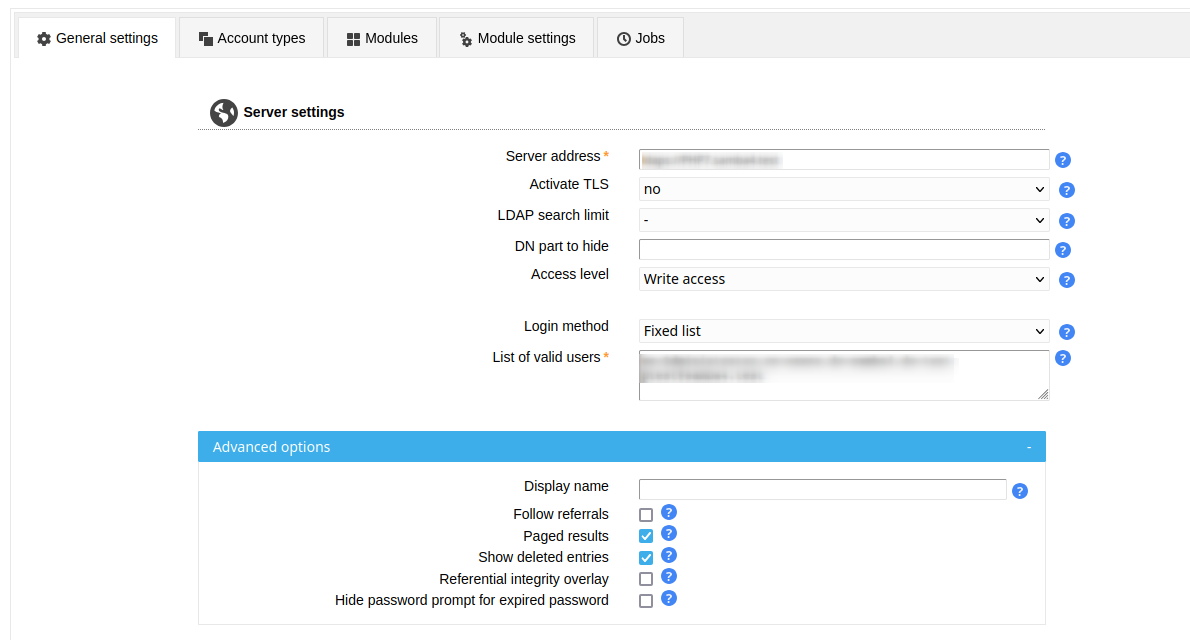
The server address of your LDAP server tin can be a DNS name or an IP address. Use ldap:// for unencrypted LDAP connections or TLS encrypted connections. LDAP+SSL (LDAPS) encrypted connections are specified with ldaps://. The port value is optional. TLS cannot be combined with ldaps://.
Hint: If you lot use a primary/slave setup with referrals then bespeak LAM to your master server. Due to bugs in the underlying LDAP libraries pointing to a slave might crusade issues on write operations.
LAM includes an LDAP browser which allows direct modification of LDAP entries. If you would like to utilize information technology then enter the LDAP suffix at "Tree suffix".
The search limit is used to reduce the number of search results which are returned by your LDAP server.
The access level specifies if LAM should allow to modify LDAP entries. This characteristic is just available in LAM Pro. LAM non-Pro releases employ write access. See this page for details on the different access levels.
Advanced options
Display name: Sometimes, you may not desire to brandish the server address on the login folio. In this case you tin can setup a display name here (e.g. "Production").
Follow referrals: By default LAM will not follow LDAP referrals. This is ok for most installations. If you lot utilise LDAP referrals please activate the referral option in advanced settings.
Paged results: Paged results should be activated only if y'all run into any problems regarding size limits on Agile Directory. LAM will then query LDAP to render results in chunks of 999 entries.
Referential integrity overlay: Activate this checkbox if yous have any server side extension for referential integrity in place. In this case the server will cleanup references to LDAP entries that are deleted.
The post-obit deportment are skipped in this case:
-
Users: group of (unique) names: memberships are not deleted when user is deleted
-
Users: organizational roles: role assignments are not deleted when user is deleted
-
Groups: groupOf(Unique)Names: memberships are not deleted when group is deleted
Hide password prompt for expired password: Hides the countersign prompt when a user with expired password logs into LAM.
LAM is translated to many unlike languages. Here you can select the default linguistic communication for this server profile. The language setting may be overridden at the LAM login page.
Delight also set your fourth dimension zone hither.

LAM tin can manage user habitation directories and quotas with an external script. You tin can specify the dwelling house directory server and where the script is located. The default rights for new home directories tin be set, too.
Note: This requires lamdaemon to exist installed on the remote server. This comes as carve up package for DEB/RPM. See here.
Script server format:
-
"server": "server" is the DNS name of your script server
-
"server:Proper noun": Proper name is the display name of this server
-
"server:Proper noun:/prefix": /prefix is the directory prefix for all operations. E.thou. creating a home directory "/dwelling/user" would create "/prefix/habitation/user" and then.
You tin provide a fixed user name. If you leave the field empty and so LAM will utilize your current business relationship (the account you used to login to LAM).
In that location are ii possibilities to connect to your home directory/quota server:
-
SSH central (recommended): Please generate a SSH key pair and provide the location to the private cardinal file. If the key is protected past a password y'all tin also specify information technology here.
-
Password: If you do not set a SSH key so LAM volition try to connect with your current account (the countersign you used to login to LAM).
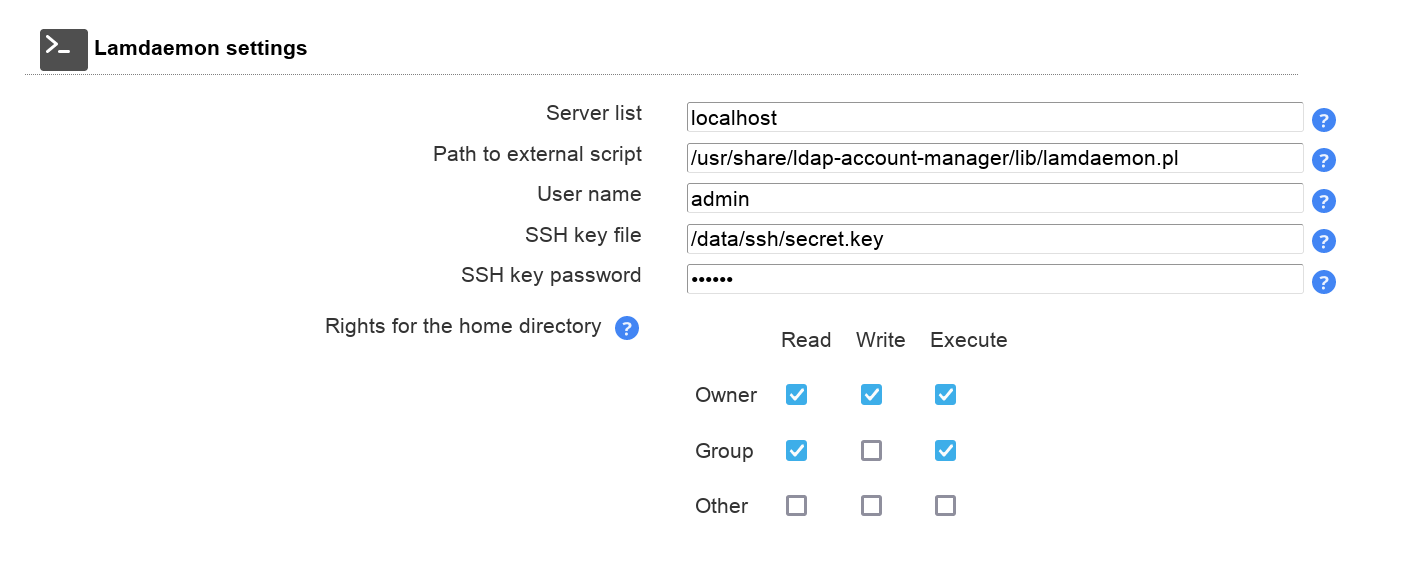
LAM Pro users may directly gear up passwords from listing view. You can configure if it should be possible to fix specific passwords and showing password on screen is allowed.

LAM Pro users can ship out changed passwords to their users. Here you lot tin can specify the options for these mails.
If you lot select "Allow alternating address" then password mails tin can be sent to any address (eastward.m. a secondary address if the user account is also bound to the mailbox).

LAM supports two methods for login:
-
Fixed listing
-
LDAP search

The commencement one is to specify a stock-still listing of LDAP DNs that are allowed to login. Delight enter 1 DN per line.
The second 1 is to let LAM search for the DN in your directory. East.g. if a user logs in with the user proper name "joe" then LAM will do an LDAP search for this user name. When it finds a matching DN then it volition use this to authenticate the user. The wildcard "%USER%" will be replaced past "joe" in this instance. This fashion you can provide login by user name, electronic mail address or other LDAP attributes.
Additionally, y'all tin enable HTTP authentication when using "LDAP search". This way the web server is responsible to authenticate your users. LAM will use the given user name + countersign for the LDAP login. You can also configure this to setup advanced login restrictions (e.m. crave group memberships for login). To setup HTTP authentication in Apache delight see this link and an case for LDAP hallmark hither.
Hint: LDAP search with group membership check can be done with either HTTP authentication or LDAP overlays like "memberOf" or "Dynamic lists". Dynamic lists allow to insert virtual attributes to your user entries. These can then exist used for the LDAP filter (e.g. "(&(uid=%USER%)(memberof=cn=admins,ou=groups,dc=company,dc=com))").
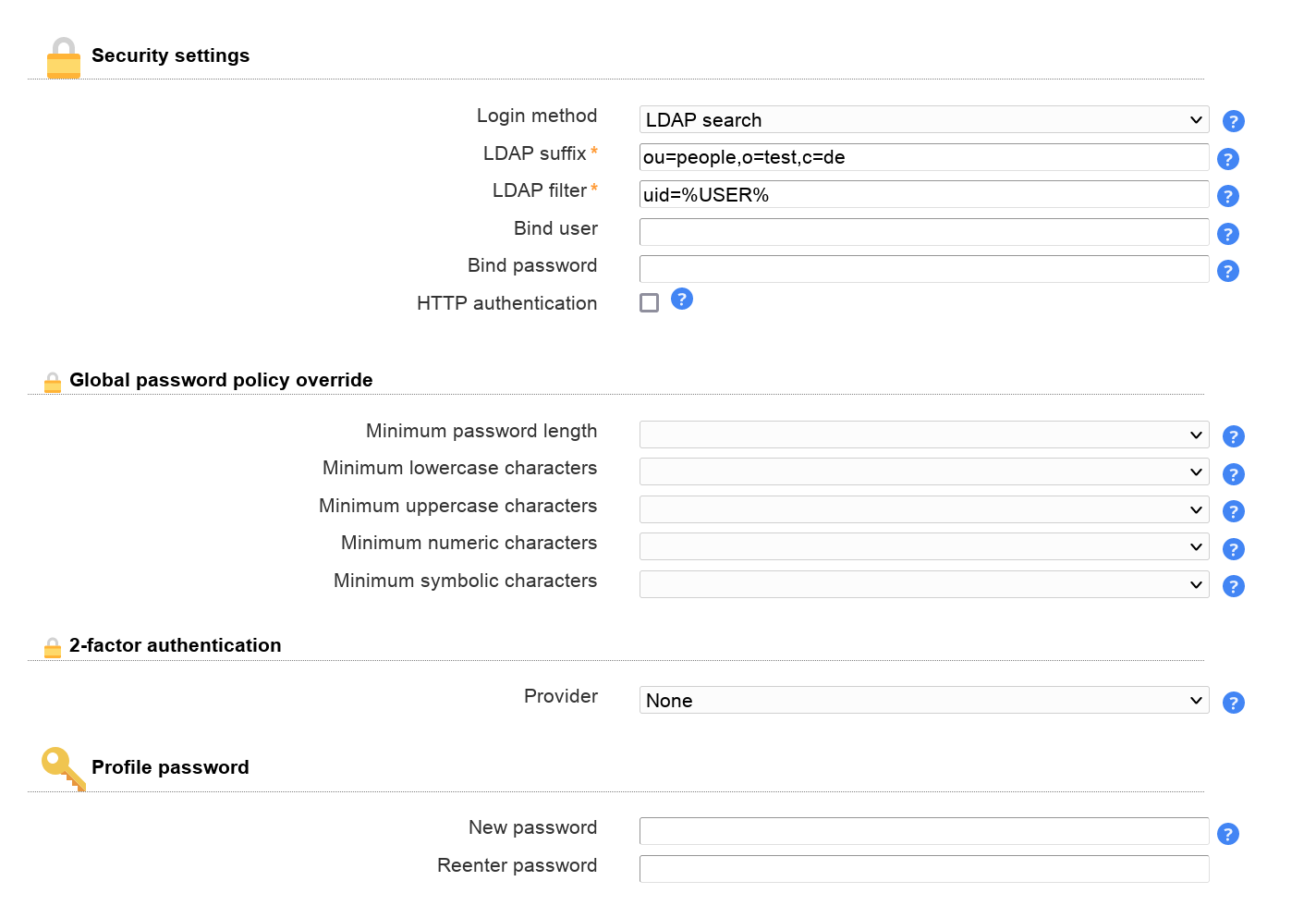
Global countersign policy override
This allows yous to override some password policy options of LAM'south global password policy (LAM main configuration). Yous can increase and decrease the values of the global policy.

2-factor authentication
LAM supports 2-factor authentication for your users. This means the user will non only authenticate by user+password but also with e.g. a token generated by a mobile device. This adds more security because the token is generated on a physically separated device (typically mobile phone).
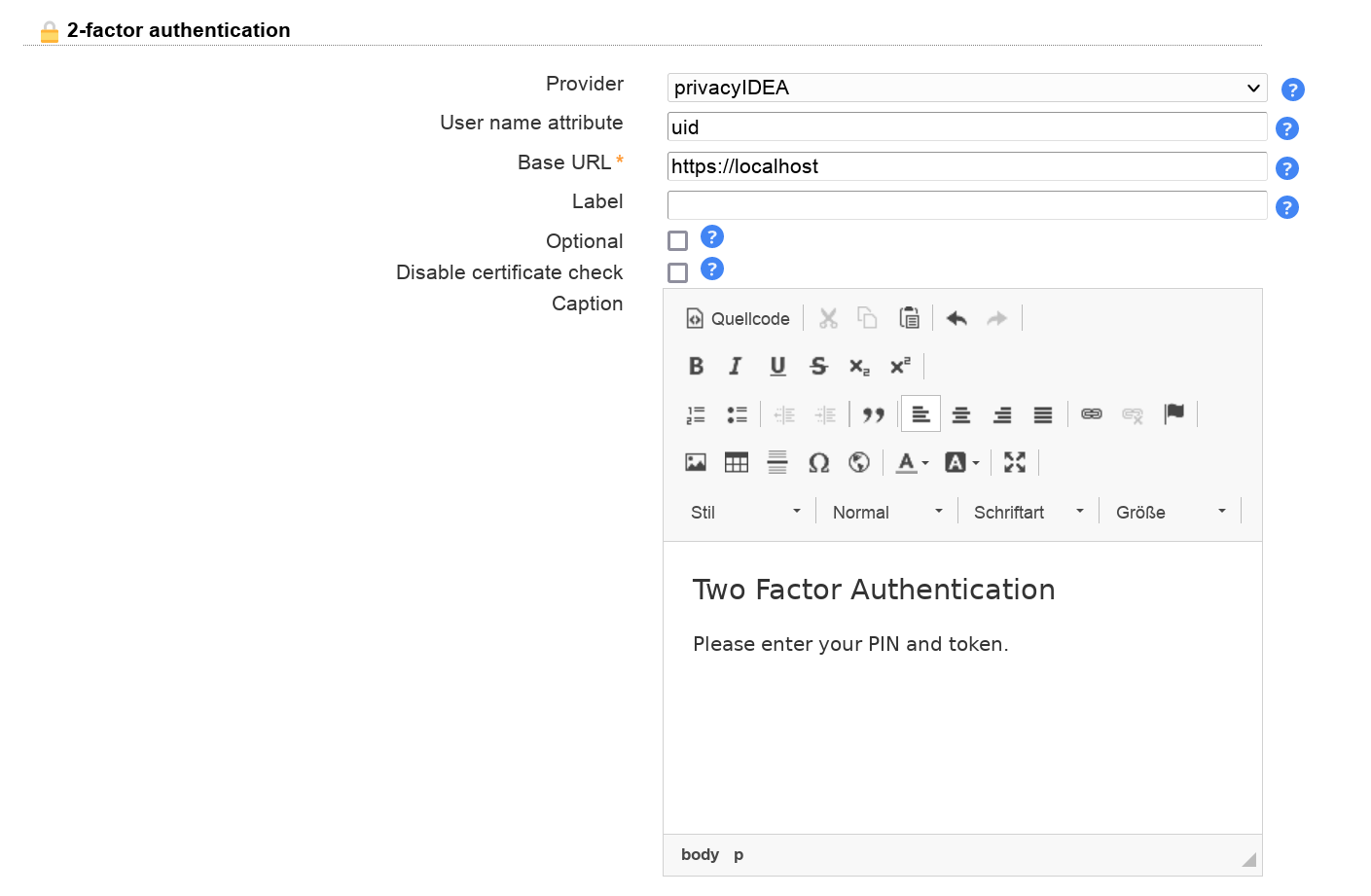
The token is validated past a second application. LAM currently supports:
-
privacyIdea
-
YubiKey
-
Duo
-
WebAuthn/FIDO2
-
Okta
-
OpenID
Configuration options:
privacyIDEA
-
Base of operations URL: please enter the URL of your privacyIDEA example
-
User proper noun aspect: please enter the LDAP attribute name that contains the user ID (e.chiliad. "uid").
-
Optional: By default LAM will enforce to use a token and reject users that did not setup 1. You lot can set this check to optional. But if a user has setup a token so this volition ever be required.
-
Disable certificate check: This should be used on development instances merely. It skips the certificate check when connecting to verification server.
Please note that LAM needs to cosign to privacyIdea with the user's user proper noun and password WITHOUT second cistron. This is needed to get the list of tokens that are setup for the user. You lot can setup a separate policy (scope: authentication) for LAM inside privacyIdea that has IP restriction ("Client" setting) to LAM'south server IP and an activity "otppin" "none".
YubiKey
-
Base of operations URLs: delight enter the URL(south) of your YubiKey verification server(s). If you run a custom verification API such as yubiserver then enter its URL (e.thousand. http://www.example.com:8000/wsapi/2.0/verify). The URL needs to end with "/wsapi/2.0/verify". For YubiKey deject these are "https://api.yubico.com/wsapi/two.0/verify", "https://api2.yubico.com/wsapi/two.0/verify", "https://api3.yubico.com/wsapi/2.0/verify", "https://api4.yubico.com/wsapi/two.0/verify" and "https://api5.yubico.com/wsapi/2.0/verify". Enter i URL per line.
-
Client id: this is only required for YubiKey deject. Yous can annals hither: https://upgrade.yubico.com/getapikey/
-
Secret cardinal: this is only required for YubiKey cloud. You lot can register hither: https://upgrade.yubico.com/getapikey/
-
Optional: Past default LAM will enforce to use a token and reject users that did non setup one. You can set this check to optional. But if a user has setup a token then this volition always be required.
-
Disable certificate cheque: This should exist used on evolution instances only. Information technology skips the certificate check when connecting to verification server.
Duo
This requires to register a new "Web SDK" application in your Duo admin panel.
-
User proper noun attribute: delight enter the LDAP attribute proper name that contains the user ID (east.g. "uid").
-
Base URL: please enter the API-URL of your Duo example (e.k. api-12345.duosecurity.com).
-
Customer id: please enter your integration key.
-
Secret key: please enter your secret primal.
WebAuthn/FIDO2
Run into the WebAuthn/FIDO2 appendix for an overview about WebAuthn/FIDO2 in LAM.
Users will be asked to register a device during login if no device is setup.
-
Domain: Please enter the WebAuthn domain. This is the public domain of the web server (e.yard. "case.com"). Do not include protocol or port. Browsers will reject authentication if the domain does not match the web server domain.
-
Optional: Past default LAM will enforce to use a 2FA device and pass up users that do not setup one. You lot can set this cheque to optional. But if a user has setup a device then this will e'er be required.
Okta
This requires to annals a new application of type "Spider web".
There, you will need to configure LAM's two-gene URLs as "Login redirect URIs" in the new application. They are "https://YOURDOMAIN/lam/templates/login2Factor.php" for admin interface and "https://YOURDOMAIN/lam/templates/selfService/selfService2Factor.php" for self service. Yous volition go an error message during login with the URL to configure in example it was wrong.
On "Sign On" tab yous need to add a rule that prompts for the cistron.
LAM options:
-
User name aspect: delight enter the LDAP attribute name that contains the user ID (e.g. "post").
-
Base of operations URL: please enter the URL of your Okta domain (eastward.g. https://mydomain.okta.com)
-
Client id: please enter your awarding client id.
-
Secret key: delight enter your application secret key.
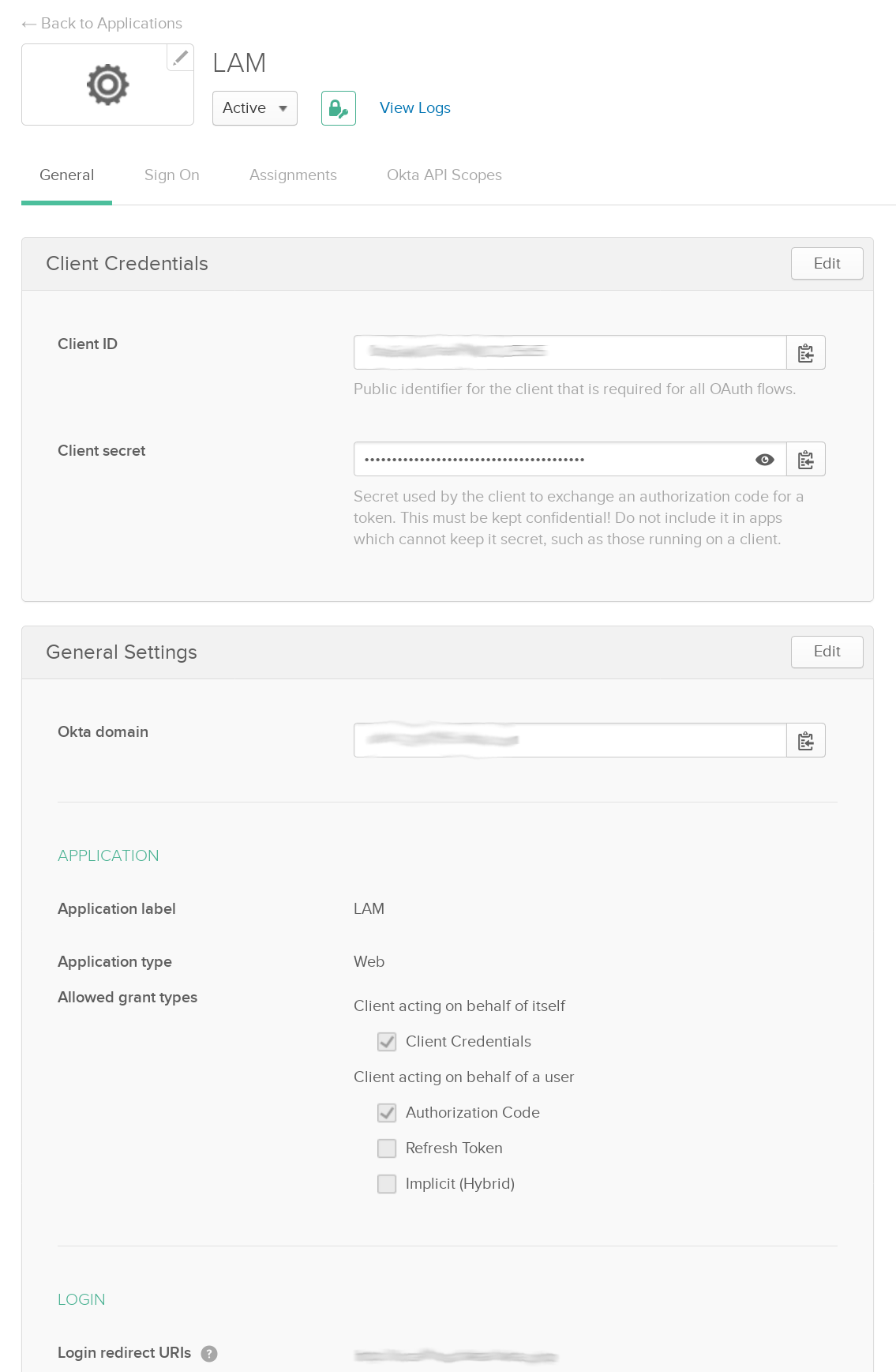
OpenID
This will employ an OpenID server as 2nd factor for authentication.
LAM options:
-
User name attribute: please enter the LDAP attribute name that contains the user ID (eastward.thou. "uid").
-
Base URL: please enter the URL of your OpenID customer URL. The URL is the one before the "/.well-known/openid-configuration".
-
Customer id: please enter your application client id.
-
Secret fundamental: please enter your application secret key.
KeyCloack example configuration:
Create a new client, select "openid-connect" protocol and enter a client ID. Root URL can exist left empty.

Now choose access type "confidential" and enter the valid redirect URLs. They are "https://YOURDOMAIN/lam/templates/login2Factor.php" for admin interface and "https://YOURDOMAIN/lam/templates/selfService/selfService2Factor.php" for self service. You will go an error message during login in case information technology was incorrect. And then save the configuration.
Next, switch to tab "Credentials" to get the client secret.

Example configuration values:
-
User proper name: uid
-
Base URL: http://openidserver/auth/realms/master
-
Client id: demo
-
Secret primal: 59bdf504-b76e-4138-8421-ef662b2c6c83
Login
Later logging in with user + password LAM will ask for the 2nd factor. If the user has setup multiple factors so he tin can choose one of them.
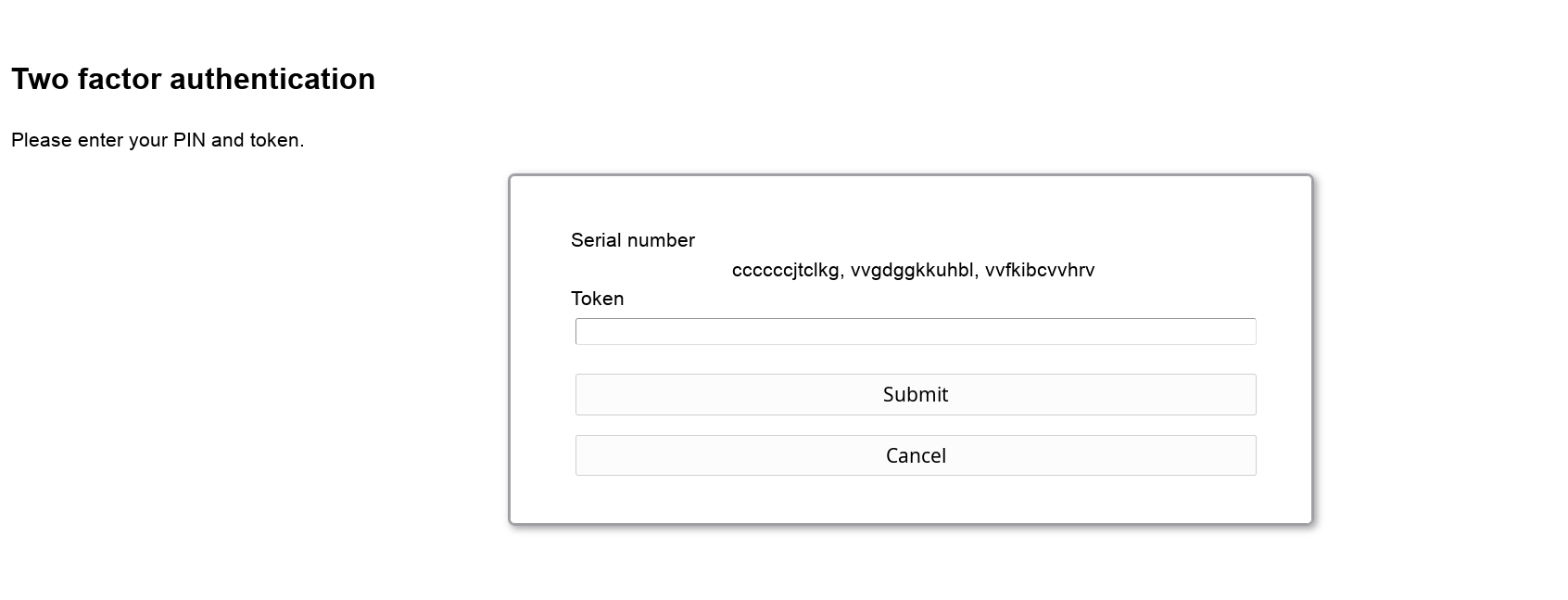
Countersign
You may likewise change the password of this server profile. Delight just enter the new password in both password fields.

Account types
LAM supports to manage various types of LDAP entries (e.chiliad. users, groups, DHCP entries, ...). On this page you can select which types of entries you want to manage with LAM.
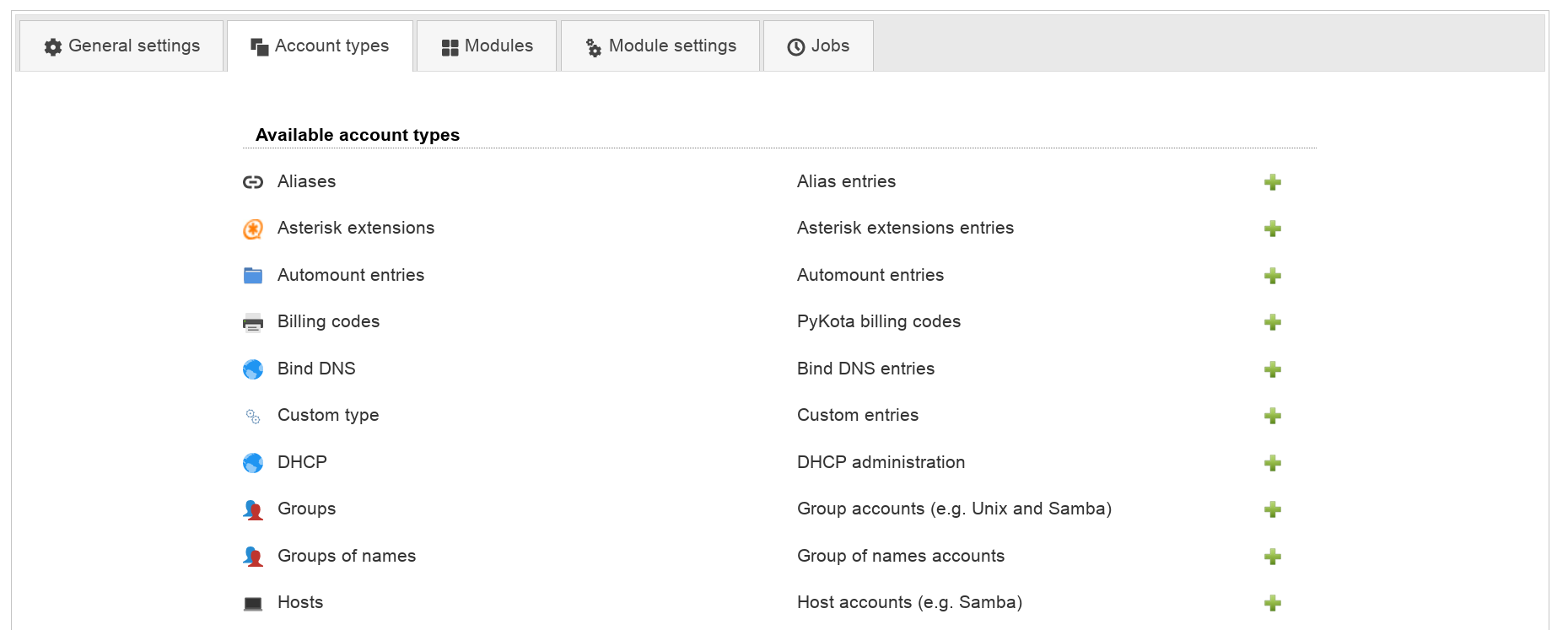
The section at the top shows a listing of possible types. You can activate them by just clicking on the plus sign next to information technology.
Each account type has the following options:
-
LDAP suffix: the LDAP suffix where entries of this blazon should be managed
-
List attributes: a list of attributes which are shown in the business relationship lists
-
Additional LDAP filter: LAM will automatically detect the right LDAP entries for each account type. This tin be used to further limit the number of visible entries (e.g. if you want to manage only some specific groups). Yous tin can utilise "@@LOGIN_DN@@" as wildcard (e.g. "(owner=@@LOGIN_DN@@)"). It will exist replaced by the DN of the user who is logged in.
-
Subconscious: This is used to hibernate account types that should not exist displayed but are required past other account types. East.g. you lot tin hide the Samba domains account type and still assign domains when you edit your users.
-
Read-only (LAM Pro only): This allows to ready a single business relationship type to read-just mode. Please note that this is a restriction on functional level (e.one thousand. grouping memberships can be changed on user folio fifty-fifty if groups are read-only) and is no replacement for setting up proper ACLs on your LDAP server.
-
Custom characterization: Hither yous tin can gear up a custom label for the business relationship types. Employ this if the standard label does non fit for you (east.yard. enter "Servers" for hosts).
-
No new entries (LAM Pro only): Use this if you lot desire to prevent that new accounts of this blazon are created past your users. The GUI will hibernate buttons to create new entries and likewise disable file upload for this blazon.
-
Disallow delete (LAM Pro only): Utilise this if y'all want to prevent that accounts of this type are deleted past your users.
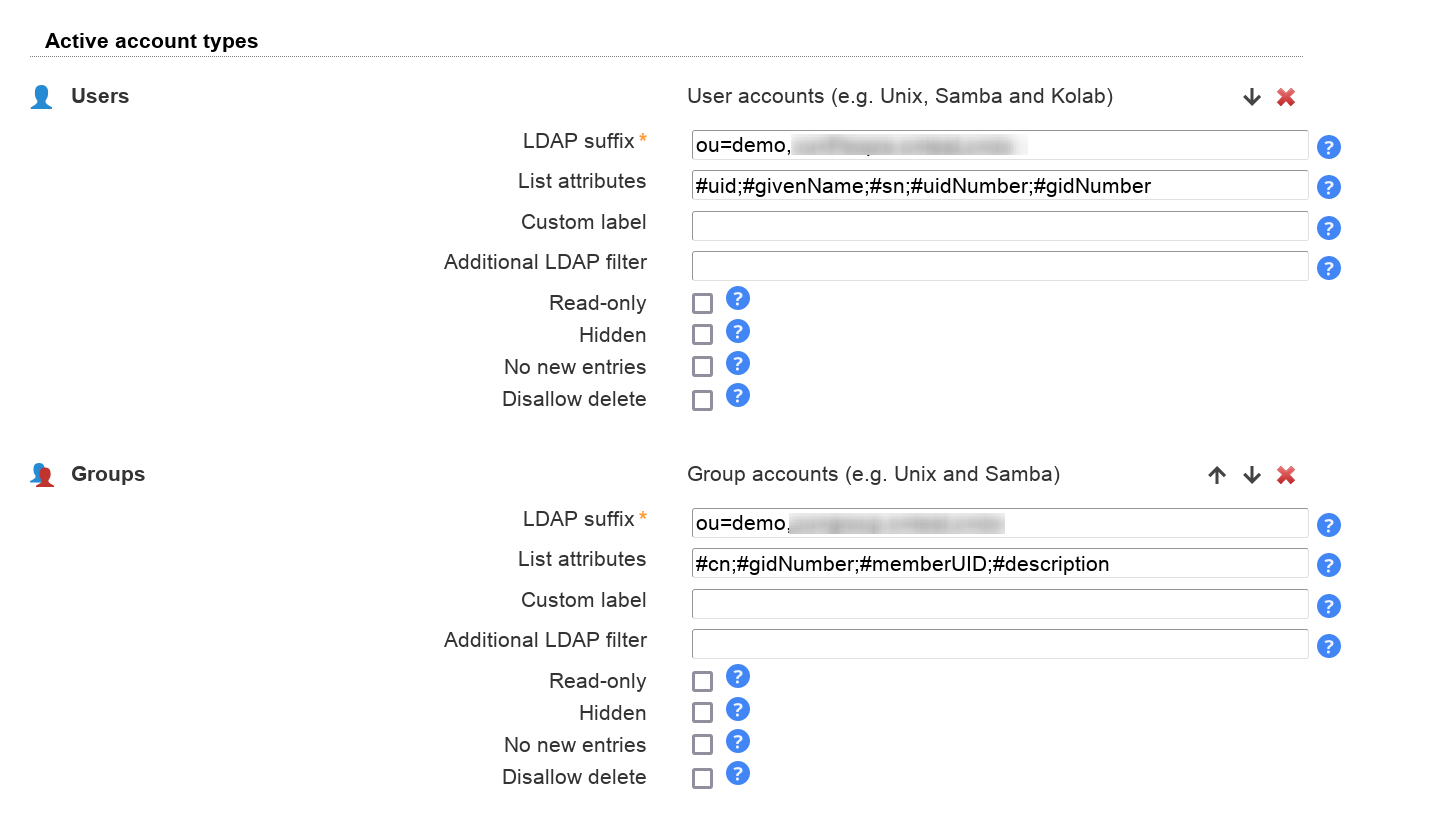
On the next page you tin can specify in detail what extensions should be enabled for each account blazon.
Modules
The modules specify the active extensions for each account blazon. Eastward.thou. here y'all can setup if your user entries should be accost book entries just or besides back up Unix or Samba.
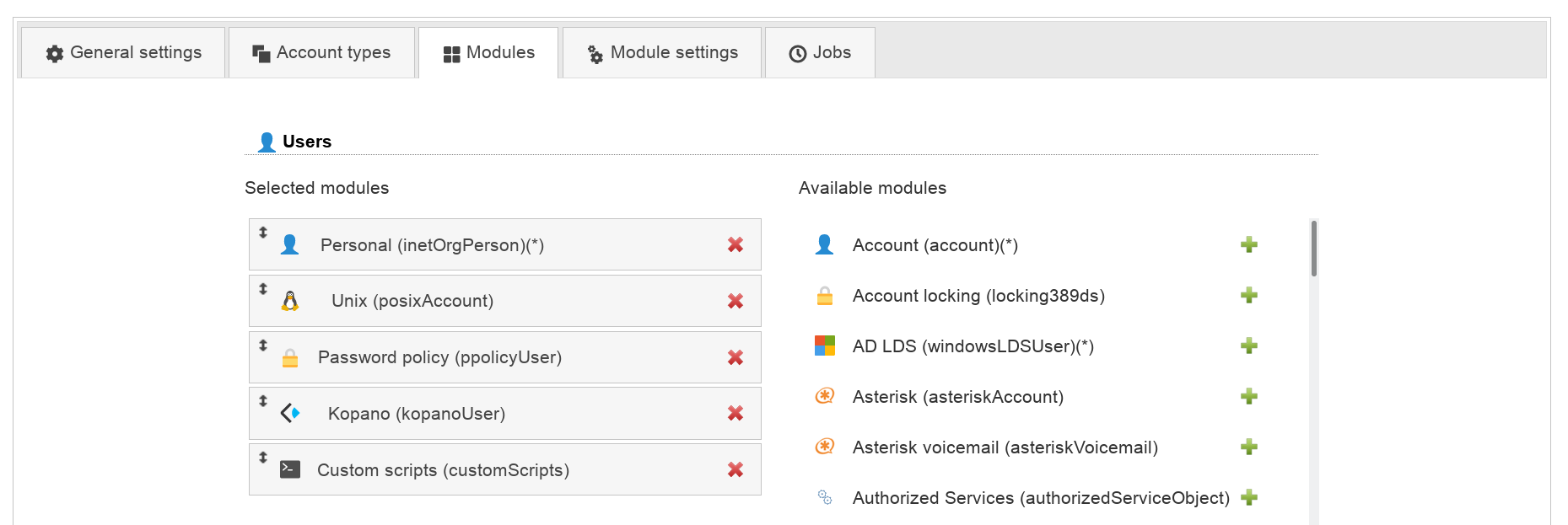
Each account type needs a and so called "base module". This is the basement for all LDAP entries of this blazon. Usually, information technology provides the structural object course for the LDAP entries. At that place must be exactly 1 active base module for each account type.
Furthermore, there may be any number of additional active account modules. E.g. you may select "Personal" as base module and Unix + Samba as additional modules.
Module settings
Depending on the activated account modules at that place may exist additional configuration options bachelor. They can be found on the "Module settings" tab. East.thou. the Personal account module allows to hide several input fields and the Unix module requires to specify ranges for UID numbers.
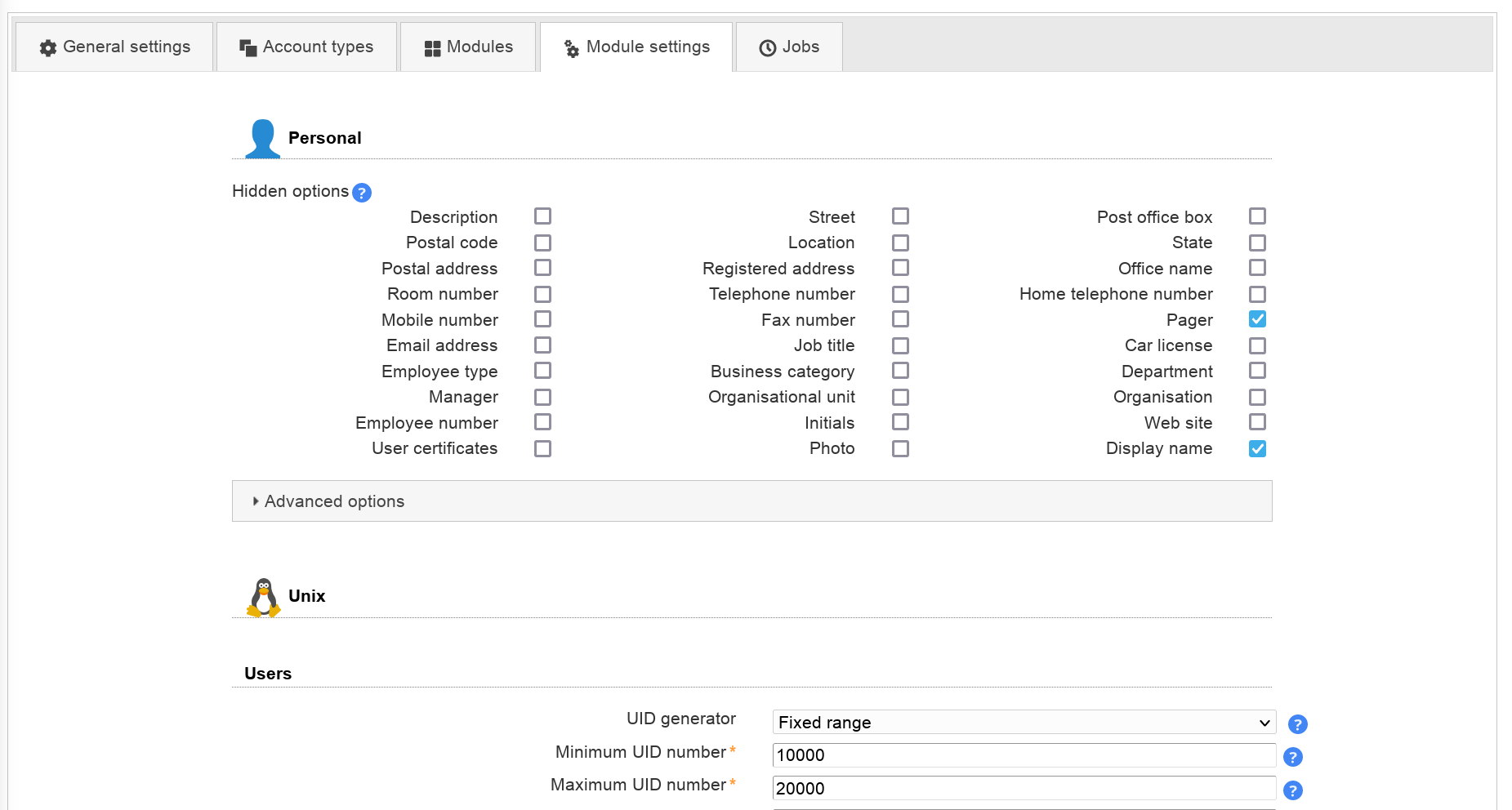
How To Add Or Delete User On Ldap,
Source: https://www.ldap-account-manager.org/static/doc/manual/ch03s02.html
Posted by: isaacslact1943.blogspot.com


0 Response to "How To Add Or Delete User On Ldap"
Post a Comment